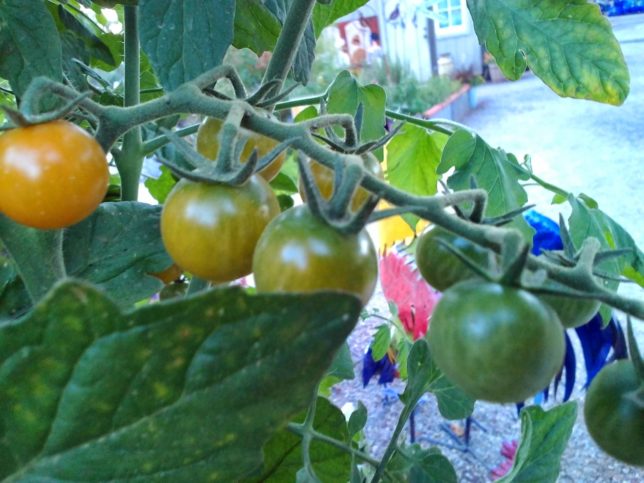
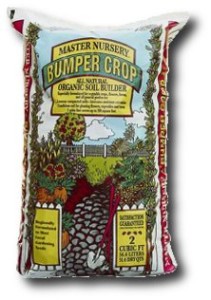
There are several key elements in growing a successful and fruitful vegetable garden, one of which is “Mother Nature”. We can’t always predict or control what nature brings, but the following steps can help improve your success rate.
Soil Preparation
Soil prep is the #1 key to a successful garden. Most of our valley soils have a high clay content and must be loosened to allow for proper drainage and better root growth. The addition of soil amendments or organic conditioners plays a big role in turning our heavy soil into “good garden loam”.
First, remove all large rocks, weeds, and debris from the planting area. For a 10′ x 10′ sq. area, rototill or work into the soil 5-8 bags of Bumper Crop, 15 pounds of E.B. Stone Tomato & Vegetable Food (use less if you use a traditional fertilizer instead of an organic selection like E.B. Stone), 5 lbs. of Iron Sulfate and between 5 and 40 pounds of gypsum. This will provide you with a soil that is better draining and rich in nutrients.
If you are planting in a raised bed, remember that the soil should be refreshed each season for maximum production. We recommend using our Master Nursery Professional Potting Soil to add soil volume to beds that have settled. Mix in Bumper Crop along with E.B. Stone Tomato & Vegetable Food, Iron Sulfate and gypsum and you are ready to “grow”.
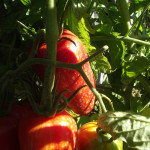
Planting
Vegetables may be started from seed or “starter” plants. A 4-inch potted plant gives you a head start in the growing process and in many cases is more efficient for the urban garden. However, if you start from seed, you will have to thin the seedlings as they grow to get stronger, healthier plants.
Spring planting is generally done after the danger of frost, which for the Valley is the first week of April. Spring/Summer crops include tomatoes, peppers, squashes, eggplants, cucumbers, corn, beans, pumpkins, strawberries, and melons. Some of your leafy green vegetables can also be grown now if given some special care.
Fall planting is generally started as the summer heat subsides, which for the Valley is on or about October 1st. Fall/Winter crops include artichokes, asparagus, broccoli, Brussels sprouts, cabbages, cauliflower, kale, lettuces, mustards, onions, peas, rhubarb, swiss chard, spinach, and potatoes in January.
When planting small starter plants, be extra gentle with the stem where it enters the ground or crown of the plant, as it can be damaged easily in transplanting and then your plant will fail. Also, make sure not to bury the stem of the plant under extra soil, the crown needs to “breathe”. The exception is tomato plants, whose stems can be buried. Each hair will turn into a root. When you plant, mix into the soil a “starter” fertilizer like E.B. Stone Sure Start. This helps the young plants develop a stronger root system.
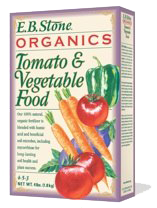
Fertilizing
Fertilization is the 2nd key component to a fruitful garden. A “starter” fertilizer like E.B Stone Sure Start, will get your young transplant off to a good beginning. After about 3-4 weeks you’ll need to start your regular fertilizing schedule.
We recommend using organic or organic based fertilizers such as E.B. Stone once a month since they provide many benefits to the crops and soil.
Fertilizers should never be applied to dry, thirsty plants. Water your plants first, let a couple hours pass then apply your fertilizer and then water the plants again. Avoid feeding on extra hot days (over 85 degrees).
Tomato & Vegetable Food 4-5-3
E.B. Stone Tomato & Vegetable Food is formulated from quality natural organic ingredients for use throughout the vegetable garden as well as with soft fruits like strawberries.
It will contribute to even plant growth without producing excessive foliage at the expense of fruit. The additional phosphorous helps to ensure the production of high-quality fruits and vegetables.
The calcium in E.B. Stone Tomato & Vegetable Food aids in preventing disorders like blossom end rot.
Watering
Watering is the 3rd key to a successful garden. Water new transplants right away and keep young, establishing plants evenly moist. A maturing vegetable garden is perfectly suited to be water-wise since veggies will fruit better if kept on the dry side. Drip systems and soaker hoses can be used for the vegetable garden. Soaker hoses, although left on for an hour or more at a trickle can still reduce water use by as much as 70%.
With drip systems, you’ll need to use 3 emitters per plant, triangulated around the plant, and run the system for 1 hour to start, then increase it to 2 hours when the plant has grown. How frequently you will have to water depends mostly on your soil’s water holding capability and secondly on weather conditions. In general, you want to thoroughly soak your vegetable plants and then let them go dry in between waterings. When you see the plants wilting (droopy), and you know it’s been awhile since you’ve watered, then it’s time to water again. However, temperature extremes will cause plants to droop even though they have enough water.
Mulching
Mulching with 3-4 inches of shredded or nugget forest material helps to conserve water, moderate soil temperatures near the crown of the plant and discourage weeds. Studies have also shown that plants that have been mulched, grow faster and develop higher yields in the long term. We recommend any Master Nursery Bark material. Mulch in late spring to allow the sun to warm the soil early on.
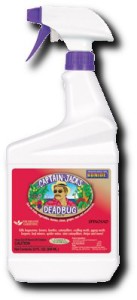
Pest Management
The first line of defense for your new plants is to protect them from snails, slugs, and earwigs with organic Sluggo Plus. Spread bait, “1 tablespoon per square yard” in a broad pattern out from the plant base of your plants. Read label directions for the frequency of reapplication. For other pest problems, it is best to identify which pest you’re dealing with before treating. If you are not sure what you’ve got, you can always bring some into the nursery in a sealed container. Ladybugs make a good biological control for aphids and some other soft-bodied insects. Captain Jack’s products, (Spinosad) and Bonide All Season Spray Oil are good broad-spectrum pesticides that are organic (OMRI approved) and treat the majority of vegetable pests.
Other Tips & Hints
- In spring, new plants should be transplanted into the ground late in the day, (just before sunset), so they will not suffer from heat stress.
- Tomato flowers will not set fruit if nighttime temperatures drop below 55 degrees and usually will drop off.
- When your tomatoes are blooming, shake the plants to aid in pollination. This will increase fruit set. (This is helpful with peppers too). Spray open yellow flowers with Bonide Blossom Set to enhance fruit set.
- Even out watering on tomato plants once the fruit has set and begins to color.
- Cooler nighttime temperatures delay the ripening of many spring veggies.
- Mix in a tablespoon of Magnesium Sulfate (Epsom Salts) in the bottom of the hole for tomatoes. Apply a tablespoon monthly through the growing season.
